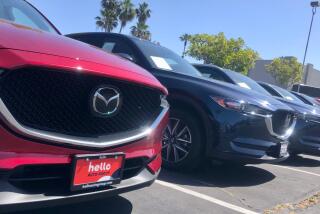U.S. Requirement on ’86 Cars : High-Mounted Brake Lights Now Standard
Effective Monday, each new auto built for sale in the United States must bear the latest mark of safety regulation: High-mounted brake lights have become standard equipment by federal mandate.
The requirement for the new brake light, primarily affecting 1986 models, was issued by the Reagan Administration despite its emphasis on deregulation, and it was generally accepted by auto makers.
The standard reflects the continuing role that safety regulators play in the making of cars. A controversial rule was issued last year on the installation of air bags or automatic seat-belt systems, and studies continue on how cars could be built to give added protection in side-impact crashes.
Putting a third brake light on a car, in the line of vision of the driver in the car behind, is “low cost, and it has a lot of benefits,” a federal auto safety official said.
On most cars, said Darwin Allen, a General Motors spokesman, the light with a red lens is “going to be on the rear of the rear seat back--that shelf extending to the rear windshield that used to be called the package shelf. We don’t call it that any more because it’s not safe to put packages there” since they could be hurled forward in a crash and injure occupants of the car.
900,000 Fewer Accidents
If the high-mounted light is inside the car, rather than outside, steps are required to be taken to prevent glare that would interfere with the driver’s ability to see through the rear window.
Once all cars on the road have high-mounted brake lights, “there will be 900,000 fewer rear-end accidents” a year, 40,000 fewer injuries and a $434-million cut in property damage costs for consumers, according to estimates from the National Highway Traffic Safety Administration (NHTSA), a unit of the Department of Transportation.
The agency estimates the cost of the brake light at $4 to $7 a car. Only a small number of 1985 cars are equipped with the device, and one such option on a Pontiac model carries a suggested price of $25.
While auto makers, consumer advocates and a group representing insurance companies agree that high-mounted brake lights can help drivers avoid accidents, there is a consensus that the device is not a lifesaver. The new light will help prevent relatively low-speed collisions that usually do not result in fatalities or severe injuries, said Clarence Ditlow, head of the private Center for Auto Safety.
“What’s important in safety standards is what saves a lot of lives and reduces serious injuries,” and that, he said, is the air bag, a device that inflates on impact and cushions the driver and front-seat passenger.
Frontal Crash Tests
After the Supreme Court said that the Department of Transportation had arbitrarily rescinded a standard to require air bags or belt systems that automatically wrap around the driver and outermost front seat passenger, Secretary of Transportation Elizabeth Hanford Dole devised a strategy that includes an escape hatch for the industry.
That rule will require that cars pass frontal crash tests at 30 miles per hour using air bags, automatic belt systems or more crash-resistant interior structures. It would begin to be phased in with at least 10% of the cars made as of Sept. 1, 1986, until Sept. 1, 1989, when all newly built cars have to comply.
The rule would be withdrawn if states with two-thirds of the population enact mandatory belt-use laws meeting federal criteria by April 1, 1989. Fourteen states, with about 40% of the population, have belt-use laws.
A lawsuit was filed against the Department of Transportation on July 11, 1984, the day the rule was announced, on behalf of four insurance companies and trade groups. The suit argues that a federal standard cannot be contingent on state actions. A decision from the U.S. Court of Appeals in Washington is awaited.
Meanwhile, Mercedes-Benz will be making air bags for drivers available in all 1986 models, according to A. B. Shuman, a spokesman for the company’s distributing arm. It is standard on certain 1985 Mercedes-Benz cars and an $880 option on others.
Ford Motor is considering offering air bags as an option on 1986 model Tempos sometime during the model year. General Motors, the largest U.S. auto maker, does not plan to offer air bags or automatic belts in the 1986 model year, said Robert LeFevre, GM’s manager for safety standards.
Side-Impact Standards
One issue still percolating at the NHTSA, and now characterized by the agency as a high priority, is possible upgrading of its standard on occupant protection in side-impact crashes. An estimated 8,000 fatalities a year are linked to such crashes.
“The current standard could be improved,” said a federal official, who agreed to be interviewed only if he were not identified. But no agreement has been reached on what a new standard would require and what test could adequately measure compliance.
By year-end, he said, the agency could decide to upgrade the standard.





